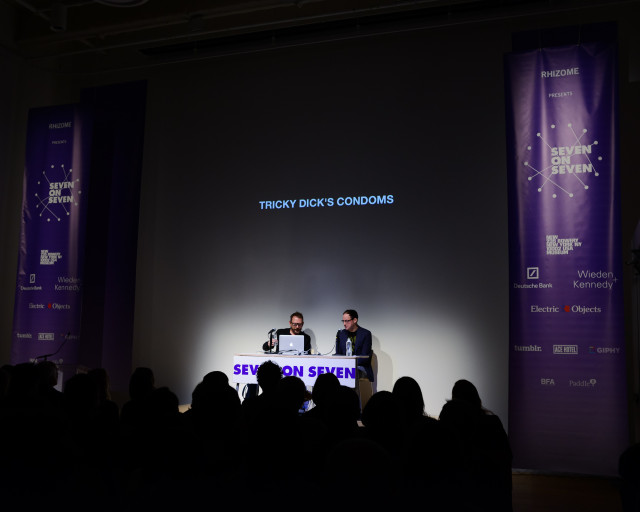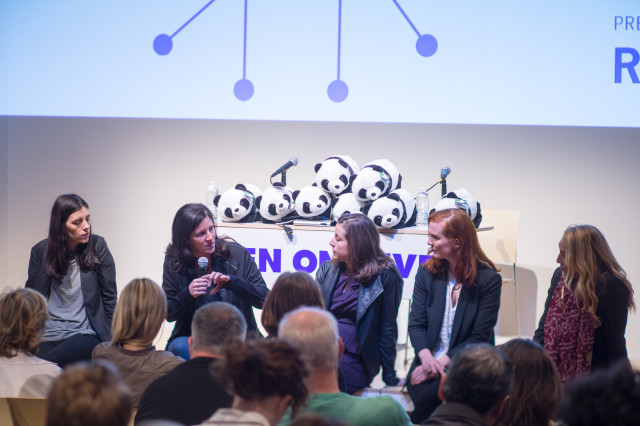
Liam Gillick and Nate Silver present at Rhizome’s Seven on Seven. Image: Madison McGaw/Billy Farrell Agency
A near jubilant crowd joined Rhizome’s semi-annual conference Seven on Seven this past Saturday at the New Museum. It was the seventh iteration of the conference—now the organization’s flagship event, so many of us expected our phones to blow up in honor of the thing.
The conference pairs seven technologists with seven artists and gives them 24 hours to produce…something, be it an artwork, a product or presentation. And this year, it would be hard to imagine a better participant lineup than Rhizome cooked up: Arguably the world’s most famous artist and activist Ai Weiwei paired with Wikileaks Jacob Appelbaum. Trevor Paglen, the artist who recently shot a bunch of photos up into space with Creative Time, teamed up with Mike Krieger, the co-founder of Instagram. Nate Silver, founder of the influential statistics blog FiveThirtyEight, would present with YBA conceptual artist Liam Gillick. That’s not even half the participants. (Others included Camille Henrot and Harlo Holmes, Martine Syms and Gina Trapani, Hannah Black and thricedotted, and Stanya Kahn and Rus Yusupov.)
Sometimes, though, even the best lineups disappoint. That might overstate the results of this year’s conference and audience reaction. The keynote conversation between Filmmaker Laura Poitras and data scholar Kate Crawford was exceptional—hitting hard on the topic of surveillance—and if the crowd was critical of the presentations, it didn’t seem to hamper their enjoyment. But this year, there were fewer than usual products produced and I often found quality of the presentations outpaced projects themselves. Given the all the talent Rhizome brought into the room, it was a bit of a let down to see so many pairings fail to live up to their potential.
That’s a risk the organization takes each time the conference runs, though, and to be fair, only two presentations flopped in their entirety. Nate Silver and Liam Gillick simply a projected a mildly entertaining series of lapsed trademarks to a generic synthy soundtrack. “Rent the Chicken” “Gold Rush Sauce” and “Health is Wealth” flashed overhead as they explained that the lapsed trademarks represented failure. That took about five minutes—the rest of the presentation was just filler. Similarly, Gina Trapani and Martine Syms’ get-to-know-you questionnaire didn’t offer much. The questionnaire asks users security questions, the take home being that we give away very personal information easily. Fair enough—but “what was the name of your best friend in grade school” isn’t giving away much.

Camille Henrot, Harlo Holmes presenting at Rhizome’s Seven on Seven. Image: Madison McGaw/Billy Farrell Agency
Camille Henrot and Harlo Holmes mined similar territory more successfully by creating a search program that helps users understand themselves better. Rather than sourcing the crowd a la Google, though, this project wants to search the mind. As such, the artist identified the desktop as the best reflection of that, and created a program that would seek answers from that source only. In other words, if the unsorted items on your desktop are analogous dreams—fragments you have yet to process—then an internal search might prove more fruitful than a search engine. Images and assembled text get pulled up with each query.
This seemed pretty poetic to me, but no search script was released, so it was impossible to know for sure; obviously any result from another computer will be meaningless to everyone but the owner.
By the time the Henrot and Holmes presentation concluded, it was clear that exposed personal narratives provided through line for many of the presentations, even when unintentional. Undoubtedly my favorite presentation (though not the strongest)—a collection of vines and chats by filmmaker Stanya Kahn and vine co-founder Rus Yusupov—hilariously chronicled their failure to collaborate. Early on, Yusupov discovered Ai WeiWei and Jacob Appelbaum were given more time to produce and became unable to work. Texts like, “Let’s find out what they’re doing and then steal their idea.” showed up on screen as they told their story. The audience roared with laughter at that—nobody took him seriously—but when they told us they worked until 4 am in the morning because it took Yusupov 17 hours to get over his rage, I felt sympathy for them.
It turns out that at least part of Yusupov’s distraction could be attributed to the fact that his partner had had a baby that week—also a small vine near the end of the narrative chain. The presentation ended when Yusupov announced he was going back to his parental duties and left the stage, thus pre-empting the planned Q&A.

Heather Corcoran, Laura Poitras, Kashmir Hill, Kate Crawford, and Lisa Phillips discuss the logistics and themes of Ai WeiWei and Jacob Applebaum’s performance. At one point, Corcoran described her job as “radical administration”. Image: Madison McGraw/Billy Farrell Agency.
It was rather nice to see the joy a new family can bring to a person, particularly in the context of Ai WeiWei and Jacob Applebaum’s circumstances. Ai WeiWei—the Chinese artist whose work is famously critical of country’s government—has had his passport confiscated by the authorities and cannot leave Beijing. His family now lives in Berlin, for safety reasons. Applebaum, an American activist who helped select the documents released by Edward Snowden is also being punished by his government and can’t return to the United States.
Needless to say, a regular ol’ Seven on Seven collaboration wasn’t going to happen in New York, so Applebaum traveled to Beijing to work with Ai. There, they were joined by documentary filmmaker Laura Poitras, who produced a short documentary for their presentation.
I know it sounds a little over the top, but the results made me proud to even be a witness. Applebaum brought the trove of classified documents Snowden released to the press, revealing global surveillance programs, which the two then shredded. The paper was used to stuff toy pandas—also the name for undercover police in China—which would also contain a small SD card with the same documents. Rhizome’s Executive Director Heather Corcoran then took the bears back to the United States where they were displayed for us, before their distribution to other similar-minded dissidents.
In theory, this piece could force a more responsible government. It’s a big fucking deal, but in the spirit of Seven on Seven, also a bit of a gamble. There’s no guarantee we can activate the potential Ai and Applebaum brought into the room, only the belief it’s important it exist. What happens next is up to us, and that’s both the terror and thrill of it.


Comments on this entry are closed.